Sights and Activities
Below are the places we saw and activities completed while visiting Peru:
Arequipa
Plaza de Armas: this plaza is surrounded by the cathedral, the city gates, the church Iglesia de la Compañía, another church Iglesia Nuestra Señora de la Merced, and in the center a bronze fountain. Many of these structures are built out of sillar, a white volcanic stone that gives the city its nickname of the ‘the white city.’
Arequipa Cathedral: this neoclassical cathedral is made of sillar stone and was one of the first religious monuments of the 17th century.
Iglesia de la Compañia: one of Arequipa’s oldest churches, this Jesuit church is noted for its ornate main facade.


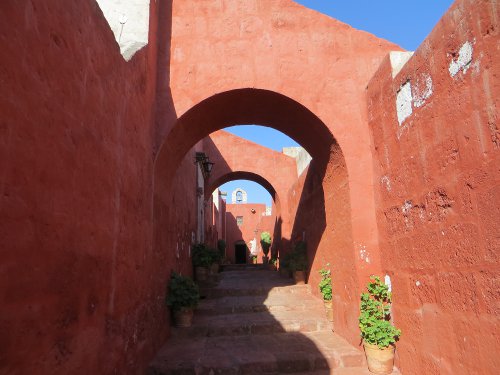
Museo Santuarios Andinos: this museum is dedicated to ‘Juanita, the Ice Princess,’ the frozen Inca girl who was sacrificed on the summit of Ampato over 500 years ago and found in 1995. At this high altitude, the body was naturally mummified by the freezing temperatures. The body is displayed in a vacuum sealed casing in a very cold room.
Monasterio de Santa Catalina: occupying a whole block, this nun monastery is practically a citadel within the city. We roamed around this maze-like monastery full of twisting streets and beautiful plazas and courtyards that was founded in 1580 by a wealthy widow who chose her nuns from the richest Spanish families. After almost three centuries of these hedonistic actions, a strict Dominican nun arrived to straighten things out.
Barrio Yanahuara: a peaceful suburb well known for its buildings built of sillar stone. The popular plaza is surrounded by the Church San Juan Batista and a spectacular lookout point overseeing the city and the Misti Volcano.
Mirador de Sachaca: this 19m (62 ft) high lookout tower is located in the countryside of the city. It was built in 1988 and offers a full 360-degree view of the surroundings including the city of Arequipa and the volcanos Misti, Chachani, and Pichu Pichu.

Cabanaconde
Colca Canyon: we spent two days exploring the second world’s deepest canyon at 3191m (10,470 ft). Starting from Cabanaconde at 3287m (10,784 ft), we trekked down the mostly dry canyon passing the villages of San Juan de Chuccho, Cosñirhua, Malata, and finally arriving to Sangalle el Oasis at 2180m (7152 ft) after 8.5 hours. The oasis was full of water, palms, and other greenery. We camped one night in the oasis before climbing the 1,100 meters (3610 ft) directly back to Cabanaconde in four hours.
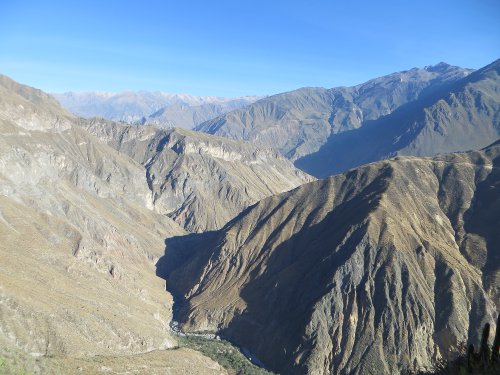
Ica
Museo Regional de Ica: this museum houses a collection of artifacts from the Paracas, Nazca, Wari, Chincha, and Inca cultures. In the back of the museum, they have a scale model of the Nazca Lines, which was interesting to see especially since we did not see the actual ones.
Wine and Pisco Tasting: We spent a couple hours tasting local wine and pisco in two different bodegas. We visited Bodega Catador and Bodega Lazo. Although the quality and taste was not to our liking, it was interesting to see the traditional process by which they make the wine and pisco.
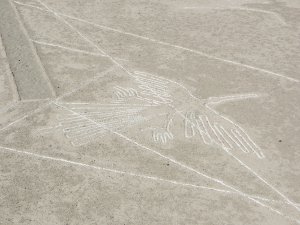

Huacachina
This oasis in the middle of the desert is has a majestic setting amongst mountainous sand dunes that roll into town over the picturesque lagoon. We spent an afternoon hiking up dunes, admiring the palm tree-filled town from high above, and watching the beautiful sunset.

Lima
Huaca Huallamarca: this restored adobe pyramid was built in about 500 AD. From the top platform, you could see the changes of millenniums as you stare at all the modern high rises.
Huaca Pucllana: the entrance to this adobe pyramid included a guided tour explaining the findings of archaeologists. The pyramid is believed to be built by the Lima culture at about 400 AD and after conquered by the Wari and then the Inca cultures, it was modified for their use.
Miraflores/Malecon: this affluent district of Lima contains various hotels, restaurants, bars, nightclubs, and department stores, but also has some great views of the bay along the malecon (boardwalk).
Morro Solar: located in the South point of the city, this hill offers great views of Lima and the bay. It is also the site of a giant Christ statue.
Barranco: this district is considered to be the city’s most romantic and bohemian, being the home and working place of many of Peru’s leading artists, musicians, designers and photographers. We strolled around the streets one afternoon and into the evening having some drinks at a bar.
Plaza San Martin: this early 20th-century plaza features a bronze statue of liberator General Jose de San Martin. Below San Martin’s statue, there is a statue of Madre Patria (a lady representing the Motherland) with a llama on her head. It was commissioned in Spain under instruction to give her a crown of flames, but the word flame in Spanish has a double meaning (flame and llama) and no one specified either so the craftsmen placed a delightful little llama on her head.
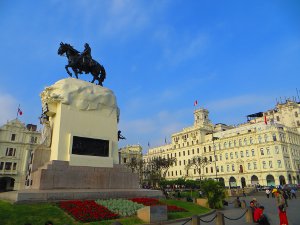

Plaza de Armas: the oldest part of this plaza is its central bronze fountain, erected in 1650. Surrounding the plaza is the cathedral, the Archbishop’s Palace that dates from around 1924, and the Palacio de Gobierno that is the home of Peru’s president.
Lima Cathedral: originally built in 1555, this church has been destroyed by earthquakes and reconstructed several times, most recently in 1746. Although we did not go inside, we were told the cathedral contains the coffin of Francisco Pizarro.
Monasterio de San Francisco: we went inside the church of this monastery that was restored to its original baroque style with Moorish influence.
Museo de la Cultura Peruana: this museum contained objects on Peruvian indigenous groups and Peruvian folk art.
Museo del Congreso y de la Inquisicion: we toured the old congress building used during the Spanish inquisition from 1570 to 1820. We explored the different rooms on the first floor and the basement where prisoners were tortured.
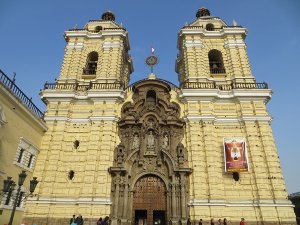
Trujillo
Museo de Arqueologia: this archaeological museum presented Peruvian history from 12,000 BC to the present day.
Plaza de Armas: this is the main square where the Spanish foundation of the city was made and is surrounded by the Municipality Palace and the Cathedral.
Trujillo Cathedral: this freshly painted 18th-century cathedral fronts the Plaza de Armas.
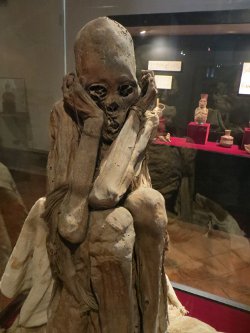
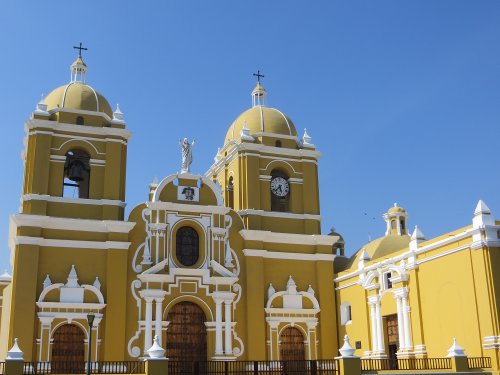
Huaca de la Luna y del Sol: we started our visit here at the Museo Huacas de Moches, an impressive museum with ceramics discovered on the site and attributed to the Moche culture. Our guided tour took us through Huaca de la Luna (Moon Temple) rooms containing famous Moche decorations and learning about their custom of ‘burying’ old temples under new ones. The Huaca del Sol (Sun Temple) is Peru’s largest pre-Columbian structure built with 140 million adobe bricks, but now resembles a giant sand pile. The Huaca del Sol was in the process of been researched or excavated by archaeologists and therefore not open to visitors.
Huanchaco
Chan Chan Ruins: this Chimu empire was built around 1300 AD. It is the largest pre-Columbian city in the Americas and the largest adobe city in the world. At its height the complex housed an estimated 50 to 60,000 inhabitants in thousands of structures, from royal palaces to huge burial mounds. The Incas conquered the Chimu around 1460, but the city was not looted until the gold-hungry Spanish arrived. The Chimú capital contained nine subcities, or royal compounds, and only one is open to visitors. Complex walls once stood over 10m (33 ft) high with impressive decorations of fish, waves, and sea life.
Museo de Sitio Chan Chan: after touring the ruins, we went to visit this museum to see artifacts and learn more about the Chimu and their grand Chan Chan complex. We saw many idols of wood, ceramic, textiles, metal, and materials used during construction.

Huanchaco Beach: once a small fishing village, this beach town has turned into a surfer and bohemian dream. Walking along the beach, we could see the remains of the cigar-shaped totora (local reed) boats called caballitos (little horses) that fishermen use, but now are more of a tourist attraction.
Huaca Esmeralda: this archaeological building belonged to the Chimu culture. It is estimated that the adobe construction was done during the first stage of development of the Chimu culture, in close link with the capital Chan Chan.
Huaca Arco Iris: this Rainbow Temple, also known as Huaca del Dragon (Dragon Temple), is a large religious monument constructed of adobe with murals decorated with friezes in relief showing human figures and representing a rainbow.
Chachapoyas
Kuelap: this pre-Inca citadel was built between 900 and 1100 AD, perched in the mountains southeast of Chachapoyas, which is also the name of the civilization responsible for its construction. At an elevation of 3000m (9843 ft) and built on a ridge, it is believed that the Chachapoya culture built the fortress to protect themselves against the Wari. Anywhere from 2000 to 3000 people could have lived in the complex.

Ayacucho
Arco del Triunfo: this arch represents and is in memory of the victory against the Spanish, it was constructed in May 2, 1886.
Plaza Mayor: located in the city center, this plaza is also known as Plaza de Armas, like many other plazas in the country or even in Latin America. It is the largest plaza in the country.

Ayacucho Cathedral: this 17th-century cathedral was declared a Historic Cultural Heritage of the Nation of Peru in 1972. It is located in the Plaza Mayor with a renaissance baroque design and constructed between 1632 and 1672.


Museo de Arte Popular: this tiny museum featured local folk artwork.
Templo de Santo Domingo: we were able to enter this 16th century temple and go up to the bell tower with magnificent views of the city. On the left side of the façade there is a triple-arched bell tower where it is said the nonbelievers were punished during the Inquisition.
Museo de la Memoria: this museum is made by ANFASEP, an organization of the families of the disappeared during the time of the Sendero Luminoso. It is a haunting museum depicting the horrific crimes committed by both the leftist-guerilla group and the government’s army. The majority of the victims during this time were of Quechua speaking descent.
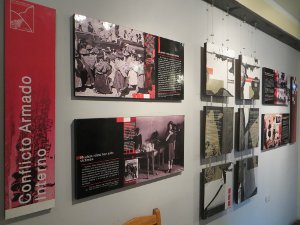

Wari Ruins: this large complex is the capital of the Wari Empire, which predated the Incas by five centuries. The ruins are amongst cacti and it is said that they appear to be in almost the same condition as they were during the days of the powerful empire. This was a highly organized city with residential, administrative, and religious areas.
Quinua: after having lunch in the local market of this village, we walked around admiring the famous ceramic handicrafts that are placed on the rooftops of their houses. We also visited the 44m (144 ft) monument that marked the site of the Battle of Ayacucho in 1824, known as the final battle for independence against the Spanish.
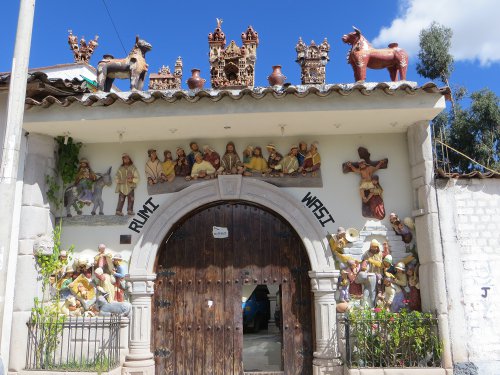
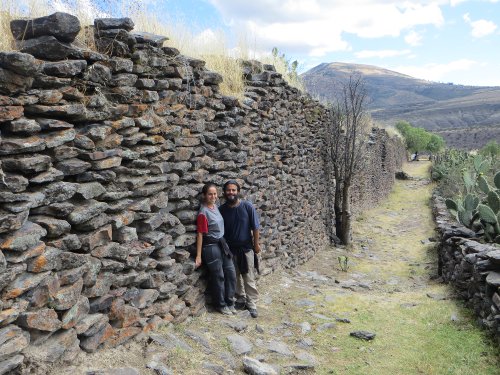
Cuzco
Museo de Sitio de Qorikancha: this museum explained the Inca way of life from their ceramics and metallurgy, mummies and deformed skulls to agriculture and spiritual beliefs.
Museo de Arte Popular: this museum featured different local folk art, ceramics, and paintings.
Plaza de Armas: the former heart of the ancient Inca capital, known to them as the “square of the warrior,” has been the site of several important events in history, such as the proclamation by Francisco Pizarro in the conquest of Cuzco and the death of Túpac Amaru II, considered the indigenous leader of the resistance. Inca walls line an alley leading away from the plaza, one of the walls is the oldest Inca wall in Cuzco that was part of the Acllahuasi (House of the Chosen Women) and after the conquest became part of Santa Catalina, so it went from housing Virgins of the Sun to housing pious Catholic nuns. The other wall is Amaruqancha (Courtyard of the Serpents), the site of the palace of Inca Huayna Capaq and after the conquest, the Iglesia de la Compañía de Jesús was built here.
Iglesia de la Compañia de Jesus: this church located in the Plaza de Armas was initiated by the Jesuits in 1576 on the foundations of the Amaruqancha or the palace of the Inca ruler Huayna Capaq, is considered one of the best examples of colonial baroque style in the Americas.

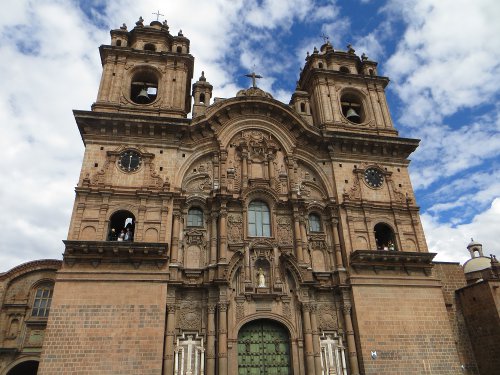
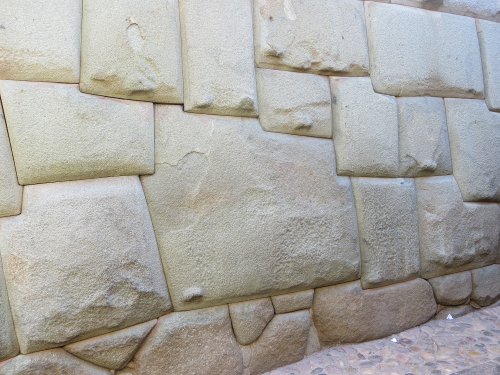
Cuzco Cathedral: taking almost 100 years to build between 1560 and 1664, this cathedral sits on the site of Inca Viracocha’s palace in what is now the Plaza de Armas. The church was erected using blocks from the Inca complex of Saqsaywaman.
12-sided stone: along an Inca wall near the Plaza de Armas we admired the perfectly fitted and sanded stones that were used to build the wall. One of these stones contains 12 sides that is an unbelievable example of the craftsmanship used by this civilization.
Museo Historico Regional: this museum is housed inside the beautiful Casa Inca Garcilaso de la Vega, a writer and historian. The exhibitions included regional pre-history, theories on how the first natives arrived to the Americas, pre-Inca culture and tribes, Inca Empire, the colonization and inquisition period, Peruvian culinary, and Peru’s independence.
Iglesia de San Blas: this church, like many in the city, was built over a sacred Inca temple in 1544.
Pikillacta: meaning “flea place” in Quechua, these ruins were once used by the Wari culture for ceremonies approximately during 550 to 1100 AD.

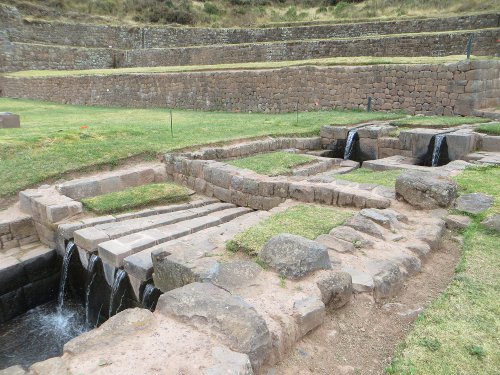
Tipon: these set of terraces were an Inca engineering marvel, experts think it was used for agriculture and spiritual ceremonies. The terraces are intertwined with channels of water for irrigation. The Incas built a fountain where the water appears out of the ground that, in addition to the rest of the site, remains perfectly intact. Our guide mentioned to us that until this day they do not know where this underground water comes from.
Museo Municipal de Arte Contemporanea: this museum contained contemporary paintings and photos from regional artists.
Qorikancha Ruins/Iglesia Santo Domingo: in Inca times, Qorikancha (Quechua for ‘golden courtyard’) was literally covered with gold. This temple was the most important temple for the Incas in Cusco that was used for religious ceremonies celestial observatory. Today, all that remains of the Inca Empire’s richest temple is its masterly stonework, the Spanish colonists built the Church of Santo Domingo on the site, demolishing the temple and using its foundations for the cathedral. Major earthquakes severely damaged the church, but the Inca stone walls, built out of huge, tightly-interlocking blocks of stone, still stand due to their sophisticated stone masonry.


Monumento Pachacuteq: in this small museum, we learned of Pachacuteq Inka Yupanki, the ninth Inca ruling approximately from 1438 to 1472. He was from the Kingdom of Cuzco, which he transformed into the Inca Empire. In Quechua, Pachacuteq means “he who shakes the earth” and Yupanki means “with honor.” He began an era of conquest that, within three generations, expanded the Inca dominion from the valley of Cuzco to nearly the whole of western South America. At the top of the monument, there is a great panoramic view of the city.
Saqsaywaman: the name means ‘satisfied falcon’ and although the site seems huge, only about 20% of the original structure remains. Soon after the conquest, the Spaniards tore down walls and used the blocks to build their own houses and churches in Cuzco. In 1536, the fort saw one of the fiercest battles between the Spanish and Inca, who used the site as a barrier from the conquistadors. Thousands of dead littered the site after the Inca defeat, which attracted swarms of Andean condors. The tragedy was memorialized by the inclusion of eight condors in Cuzco’s coat of arms. Inca Pachacuteq envisioned Cuzco in the shape of a puma, with Saqsaywamán as the head, and 22 zigzag walls on the site form the teeth. Now the complex is used as a parade ground during Inti Raymi celebrations.
Q’Endo: the name of this fascinating small ruin means ‘zigzag.’ It is a large limestone rock with niches, steps, and extraordinary symbolic carvings, including channels that may have been used for ritual sacrifices of chicha. Below the rock is a cave with altars hewn into the rock.
Pukapukara: its name means ‘red fort,’ but it is believed to be a hunting lodge, guard post, or stopping point for travelers. The top level of this three-level structure has panoramic views.
Tambomachay: this site has a beautifully ceremonial bath that still channels clear spring water that earned it the title Inca Bath.
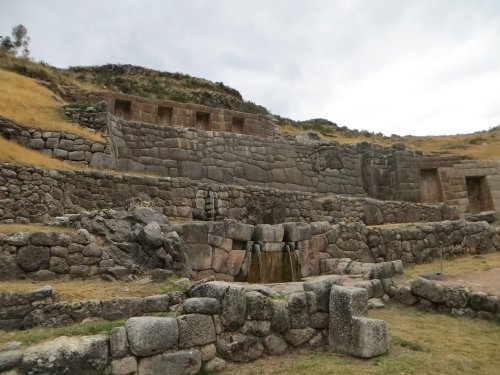

Moray: this site contains unusual Inca ruins consisting of several enormous terraced circular depressions with a sophisticated irrigation system. The exact purpose of these depressions is uncertain, but their depth, design, and orientation with respect to wind and sun creates a temperature difference of as much as 15 °C (27 °F) between the top and the bottom. It is believed that this large temperature difference was used by the Incas to study the effects of different climatic conditions on crops.
Salineras de Maras: we visited these salt puddles that were created to harvest the mineral that comes from an underground mine river. It is believed the salt has been collected since the Inca times.
Centro Qosqo de Arte Nativo: we were able to attend a performance on Andean and folklore music and dance in this venue.
Traditional Dances in Centro Qosqo de Arte Nativo
Pisac Ruins: this Inca citadel lies high above on a plateau with a plunging gorge on either side. The mountainous site contains giant terraces and hilltop ruins believed to be ceremonial temples and residences. A cliff behind the site is honeycombed with hundreds of Inca tombs robbed by grave robbers.
Ollantaytambo Ruins: the steep terraces guard this Inca complex, a site of few where the conquistadors lost a major battle, when the Incas threw missiles and flooded the plain below. This place was as much a temple as a fort to the Incas. In a stupendous feat of construction, the stone was quarried from the mountainside high above the Río Urubamba on the other side of the valley and transported in huge blocks weighing up to 150 tons. Six of these large stones are displayed in what was believed to be an unfinished sun temple.

Aguas Calientes
We decided to take a somewhat adventurous route from Cuzco to Aguas Calientes. It turned out to also be the most economical way we were able to find to get there. Be sure to read more about this journey on our article.
Machu Picchu: we spent six hours visiting this magical city. We first went straight to the Hut of the Caretaker of the Funerary Rock to view the city at sunrise and take many classic postcard pictures. We then took a guided tour of the complex learning about the Temple of the Sun, Royal Tomb, Sacred Plaza, Intihuatana (Hitching Post of the Sun), Central Plaza, and a labyrinthine complex of cells, niches and passageways with a centerpiece of a carving of the head of a condor and the natural rocks behind it resembling the bird’s outstretched wings. We ended by hiking up to the Sun Gate with a different perspective view of the city and then to the Inka bridge.
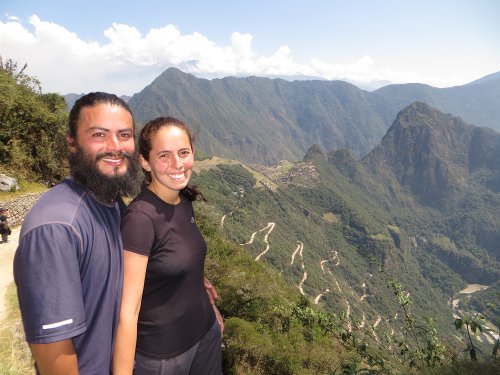
Puno
El Arco Deustua: an arch built in 1847 in honor of the patriots that were fighting in the Battle of Junin and Ayacucho.
Parque Pino: this plaza was built in 1901 in honor of Dr. Manuel Pino, a hero during the war against Chile. There is a monument commemorating him in the center of the square.
Plaza de Armas: the center of this plaza contains a monument of Coronel Francisco Bolognesi, a hero of Arica, and it is home to the cathedral.
Malecon: walking along this boardwalk offers great views of Puno’s bay in Lake Titicaca.

Lake Titicaca Islands
Uros Islands: around 80+ totora (reed) islands compose this man-made archipelago. The islands have become quite commercial, but there isn’t anything like them anywhere else. We were able to see how the islands are built using layers of the buoyant totora reeds that grow in the shallows of the lake. The Aymara people that live in the islands were always a small tribe that began their floating existence centuries ago in an effort to isolate themselves from the aggressive Incas. The islands’ reeds are constantly replenished from the top as they rot away. The inhabitants are now completely dependent on tourism to make a living.
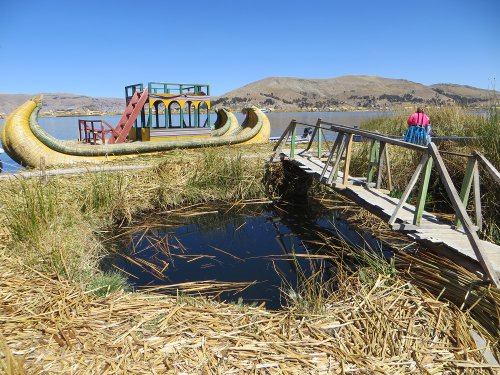
Amantani Island: we spent one night on this island with a local host couple, Evaristo and Cecilia. The Amantani Community Lodging is made up of the island’s families and allocates accommodation according to a rotating system. We were welcomed by Cecilia that took us to her house, made food for us, showed us her weaving work that she sells, and thought us some Quechua. We hiked to the ruins on top of the hills, PachaTata and PachaMama, for great views of the island. Although we did feel like this experience was a tourist trap and not very authentic, we did enjoy seeing the island’s landscape.
Taquile Island: we spent a few hours on this island’s main plaza seeing daily life as it unfolds. The Quechua-speaking islanders maintain lives minimally changed by mainland modernities and have a long tradition of weaving. Women wear multilayered skirts and delicately embroidered blouses.
